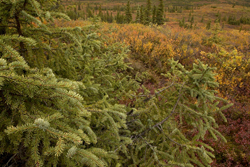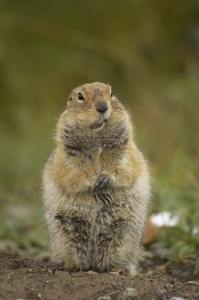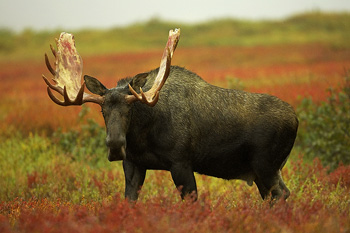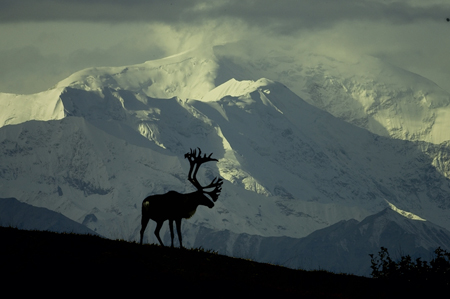
Wonder Lake and Mt.McKinley at dawn

The low clouds rolled in again, creating
a cold, dreamy landscape of grays and whites as the visibility
plummeted to a few hundred feet. The three Dall sheep rams we
were approaching vanished into this white-on-white environment
and as Steve Berkowitz and I trudged upslope I wondered if the
rams would still be visible when the clouds lifted, if indeed
they ever would. Other banks of low threatening clouds hung along
the ridge tops or rolled eastward, while ahead, uphill, the steepest
part of our hike still remained.
 An hour or so earlier our North Face Lodge tour
bus had stopped when Mary spotted the three tiny white dots far
across the valley near Stony Hill. I had hoped our Photo Tour
would have an opportunity to photograph sheep, and had planned
on leading a steep hike in to the high country where I'd seen
Dalls on previous occasions if people were interested, and if
the opportunity and weather worked in our favor. Now, on our third
full day in the Park, we had that opportunity, or so it seemed,
with three sheep that I thought were rams lying on a rocky ridge
that looked accessible and within reach.
An hour or so earlier our North Face Lodge tour
bus had stopped when Mary spotted the three tiny white dots far
across the valley near Stony Hill. I had hoped our Photo Tour
would have an opportunity to photograph sheep, and had planned
on leading a steep hike in to the high country where I'd seen
Dalls on previous occasions if people were interested, and if
the opportunity and weather worked in our favor. Now, on our third
full day in the Park, we had that opportunity, or so it seemed,
with three sheep that I thought were rams lying on a rocky ridge
that looked accessible and within reach.
I mentioned this to Mary, who looked at me as though I were nuts.
They're low, I said, but she disagreed. Well, they're within sight,
I countered, and I asked if anyone was interested in trying. Steve
raised his hand.
Walking across the tundra was easy, although the journey continually
led uphill as we tried to find a route that was reasonably gradual
and direct. Eye-balling a route from a bus two or three miles
away is one thing, but up close, in the high country, a hidden
cliff or precipice could have stopped our progress quickly and
required a new route and, even worse, perhaps the need to descend
and give up some very hard-earned elevation. Luckily, that didn't
happen, and aside from the fog and low clouds and, most aptly,
the lung-busting journey uphill, our progress went unimpeded.
It took an hour and a half to reach the sheep, with a stop to
photograph an arctic ground squirrel, which gave us a much needed
rest and a sense of accomplishment - at least we'd have shot something
on the hike. As we grew nearer we confirmed that the sheep were
rams, two with good horns and one young ram, now feeding along
the rocks and tussocks of vegetation amidst the scree and moving
slowly in our direction of travel. It's important to approach
sheep from below, as it is thought that sheep will panic, perhaps
mindful of wolves, if approached from above. Below, or from the
side, sheep are rarely concerned, and when we finally got to their
elevation we found this to be true. The sheep moved closer, feeding
along the edge of a ravine that formed a physical and psychological
barrier between us.
Just as we started our approach, Mary radioed us on our walkie-talkie
to check our progress. She and the rest of the group had remained
on the bus and had continued onward to look for bears or the pack
of wolves that this year had denned quite close to the park highway
road. With the volume raised to its highest level so that I could
hear the radio if it were inside my jacket, her voice blasted
into the still fog-shrouded landscape. Despite my worries, the
sheep ignored the noise and continued feeding. "We're about
to approach," I whispered back, and set a rendezvous time
for a few hours later. Mary wished us luck and continued eastward;
not finding any bears or wolves, but shooting a stormy tundra
landscape of color and clouds that ended up as one of the most
powerful images she made on the trip.
We moved closer to the sheep, although because of the ravine we
were still far from the 25 yard minimal distance the Park has
set for approaching wildlife. Periodically the clouds that cloaked
the slopes in a gray mist lifted and the sheep stood out starkly
against the saturated colors of grays and tundra browns, and once
the sun appeared as a silver orb through the breaking clouds.
Because of the distance and climb we took only our long lenses,
but from our high vantage, looking down in an aerial-like view
of the low clouds and rolling tundra, I regretted not having a
short zoom as the scene was haunting, and nags at me even now
as I write this.
 We spent nearly an hour with the sheep before
heading back down, timing ourselves to arrive at the bus at the
prearranged time. The bus was late, and while we waited four bears
appeared on a hillside about two-thirds of a mile to the west.
Mary radioed seconds later, and within minutes the bus appeared
and we headed toward the bears which, by the time we arrived,
were feeding within a few yards of the road. The bears, a mother
and three nearly full-grown cubs, proceeded downhill, eventually
crossing the tundra within a short distance of the exact route
Steve and I had traversed as we descended from the ridge. Had
they been only an hour earlier our return hike across the tundra
would have been very interesting.
We spent nearly an hour with the sheep before
heading back down, timing ourselves to arrive at the bus at the
prearranged time. The bus was late, and while we waited four bears
appeared on a hillside about two-thirds of a mile to the west.
Mary radioed seconds later, and within minutes the bus appeared
and we headed toward the bears which, by the time we arrived,
were feeding within a few yards of the road. The bears, a mother
and three nearly full-grown cubs, proceeded downhill, eventually
crossing the tundra within a short distance of the exact route
Steve and I had traversed as we descended from the ridge. Had
they been only an hour earlier our return hike across the tundra
would have been very interesting.
Minutes later, after the bears loped out of sight, we spotted
a herd of thirty or forty more Dall sheep closer and lower than
the ones we had worked, but we reconciled ourselves in the fact
that such a large herd would be comprised of ewes and lambs. We
didn't have enough time to attempt another approach regardless;
nor would my knees have taken another journey across the tundra
that day.
As it turned out, on our last full day in the park we found another
group of Dall rams, a few hundred feet above Eielson Visitor Center,
but again it was too late in the day to attempt an approach. These
were huge rams with great curls, but now the loose rocks and steep
slopes were covered with the first good snow of the season, and
hiking across those ridges would have been extremely treacherous.
 The snowline had dropped by several hundred feet
in the last two days, and by about one thousand feet on this,
our last day. During the six full days we'd spent at North Face
Lodge the tundra had peaked in autumnal color and for several
days the dwarf birches and blueberry bushes, bearberry and bunchberry,
and a myriad of other tundra plants had glowed in orange and red
and yellow. On our last day, as we drove out of the Park, the
changes in the landscape were particularly striking - much of
the vibrant colors were now a rusty brown, and the landscape had
the gloomy air of late fall.
The snowline had dropped by several hundred feet
in the last two days, and by about one thousand feet on this,
our last day. During the six full days we'd spent at North Face
Lodge the tundra had peaked in autumnal color and for several
days the dwarf birches and blueberry bushes, bearberry and bunchberry,
and a myriad of other tundra plants had glowed in orange and red
and yellow. On our last day, as we drove out of the Park, the
changes in the landscape were particularly striking - much of
the vibrant colors were now a rusty brown, and the landscape had
the gloomy air of late fall.
Our sheep experience was the trip's highlight for both Steve and
I, but our six days in Denali had many, and this was undoubtedly
the most productive trip I've ever done to the park. In fact,
Mary and I came to Denali with the very real intention that this
would be our last visit to the park for a very long time. In a
previous Question of the Month I have compared Denali with another
mountain park, Torres del Paine in Chile, and the comparison was
not favorable. Denali is a hard park to shoot, but as I rediscovered,
it is still an exciting and extremely productive park to film.
Denali is a hard park to shoot because to really, really do it
right, one has to be willing to walk and to put out some effort
to obtain the best shots. Unlike most National Parks, you cannot
drive into Denali unless you are awarded an extremely difficult
to receive professional photography permit. Five of these are
issued a day, good for one or several days depending, and the
requirements to obtain a permit are stringent. Alternatively,
one can board the park buses that traverse the park, which will
drop you off where ever, but not adjacent to any animal that is
close to the road. So, by the time you walk back to where the
animal was, it may be gone. Photographers leaving the bus may
also find it difficult to secure a seat in a later bus - if the
bus seats are full, you must wait for another. Supposedly, the
park buses won't maroon you in the park, but a good friend of
mine was, in fact, marooned and spent much of the night walking
until he arrived at a ranger station to obtain a ride back to
his camper. The ranger wasn't especially pleased to be awakened
at 1AM, but my friend wasn't too pleased at being abandoned at
8 or 9PM either!


 Our
second encounter with caribou at the Y was especially productive,
at least for Warren McGill and me. While doing macro I noticed
some caribou on a distant hillside about one-half mile away. Another
CD/NFL bus was parked nearby and I could see some tourists or
photographers outside of the bus watching the caribou. I grabbed
a radio and told Mary I'd call if the shooting was worthwhile,
but by the time I hiked down the road the caribou had retreated
uphill and were continuing in that direction. Still, one tourist
remained near the caribou, a good sign that the animals were not
too disturbed, so I eye-balled a route that avoided the chest-high
thickets of wet willows and circled around, hoping to get a bit
closer. As I moved uphill Warren joined me, deciding to give the
caribou a go as well.
Our
second encounter with caribou at the Y was especially productive,
at least for Warren McGill and me. While doing macro I noticed
some caribou on a distant hillside about one-half mile away. Another
CD/NFL bus was parked nearby and I could see some tourists or
photographers outside of the bus watching the caribou. I grabbed
a radio and told Mary I'd call if the shooting was worthwhile,
but by the time I hiked down the road the caribou had retreated
uphill and were continuing in that direction. Still, one tourist
remained near the caribou, a good sign that the animals were not
too disturbed, so I eye-balled a route that avoided the chest-high
thickets of wet willows and circled around, hoping to get a bit
closer. As I moved uphill Warren joined me, deciding to give the
caribou a go as well.
 We trudged uphill through spongy tundra for another
quarter-mile or so until we reached a spot roughly parallel with
the caribou. At that point the two bulls we had been following
disappeared over a rise, but seconds later they reappeared, grazing
in our direction. For the next few minutes the two bulls walked
closer and closer, requiring us to flip to a vertical format to
fit the entire animal in when a bull faced us, before they angled
off and moved higher. Several other sets of antlers appeared on
the horizon and within seconds a group of fifteen or so cows popped
over the ridge. They spotted the bulls and ran downhill to join
them, then proceeded at a gallop to run past us and toward where
we had left the group. Unfortunately, they didn't stop until they
reached another high point nearly a mile away.
We trudged uphill through spongy tundra for another
quarter-mile or so until we reached a spot roughly parallel with
the caribou. At that point the two bulls we had been following
disappeared over a rise, but seconds later they reappeared, grazing
in our direction. For the next few minutes the two bulls walked
closer and closer, requiring us to flip to a vertical format to
fit the entire animal in when a bull faced us, before they angled
off and moved higher. Several other sets of antlers appeared on
the horizon and within seconds a group of fifteen or so cows popped
over the ridge. They spotted the bulls and ran downhill to join
them, then proceeded at a gallop to run past us and toward where
we had left the group. Unfortunately, they didn't stop until they
reached another high point nearly a mile away.
Those two encounters, one with the Dall sheep and one with the
bull caribou, were really the only times we were required to hike
any distance to photograph big game. Other caribou, as well as
grizzly bear, fox, and ptarmigan, were shot right from the bus,
and smaller hikes, less than a few hundred yards from the road,
brought us into great range of willow ptarmigan, beaver, and moose,
including the best of this species that we've ever shot.
On a dreay, dark morning, two big-shoveled bull moose stood on
a ridge line about one hundred yards off the road. Alternately,
rain squalls, fog, and rainless gaps passed by, providing several
different looks as the moose ambled across the red-carpeted tundra.
When they dropped over the ridge we followed, and over the next
hour or so, until the moose finally bedded down, we did some great
work. On our return in late afternoon and without my gear I hiked
back out to check whether or not the moose were still in the area,
although I was doubtful that theywould have stayed settled all
day in a cool rain. Surprisingly, though, they were, and those
photographers who did not hike out in the morning for the moose
now did so, and were rewarded with one view in particular - overlooking
the moose lying in the orange-red low dwarf birches - that was
truly spectacular.






Throughout our stay tundra color was at its peak, and while we
had been disappointed that we couldn't schedule the week following
our visit, another photo group, leaving on the bus we'd take into
the park, informed us that we were hitting the peak autumnal color.
Had we been 'lucky' and able to book the weeks we had hoped for,
we'd have missed the peak by four full days!
By the last full day of our photo tour only beaver remained to
be filmed, but again, almost as if our shooting was set to a schedule,
we again had luck. We had been told of an active pond fairly close
to the road but when we arrived nothing was visible. Nonetheless,
we decided to give it a crack, and after negotiating through some
swamp-like terrain (I found an easy route on the way back, of
course!) we positioned ourselves in view of the large beaver lodge.
Within ten minutes beavers appeared at the far end of the large
lake, swimming toward the lodge with various sized willow and
birch limbs in tow. Considering that beavers only swim with their
hind legs they moved surprisingly fast, and after the first few
visits, one or two of these huge rodents grew curious and swam
close by our group. One circled the cache of limbs they had been
storing offshore - under the water, beavers stow limbs in piles
and in the mud around the lodge for easy access during the months
when their ponds are covered with ice - and swam up to the edge
of the lodge. I had hoped to film one standing on the lodge, but
we weren't that lucky. Instead, the beaver climbed to the edge
of the lodge, almost completely visible above the water line,
and proceeded to gnaw on a willow it had carried along.
 After that performance we were ready to move
off, but instead of leading the group out as I normally do, I
decided to take off my 1.4X tele-converter before I hiked back
to the bus. Just as I did so Warren or Steve whistled my attention
and pointed behind me. The beaver had returned, and swam back
to the same feeding location as before. The three of us began
shooting, and this time the beaver swam even closer, waddling
to the pond's edge to gather mud and grasses that I hoped it'd
pull up onto the lodge. It didn't, but instead dove and, I presume,
used the mulch to line the inside of the lodge. It didn't reappear
and we double-timed back to the rest of our waiting group.
After that performance we were ready to move
off, but instead of leading the group out as I normally do, I
decided to take off my 1.4X tele-converter before I hiked back
to the bus. Just as I did so Warren or Steve whistled my attention
and pointed behind me. The beaver had returned, and swam back
to the same feeding location as before. The three of us began
shooting, and this time the beaver swam even closer, waddling
to the pond's edge to gather mud and grasses that I hoped it'd
pull up onto the lodge. It didn't, but instead dove and, I presume,
used the mulch to line the inside of the lodge. It didn't reappear
and we double-timed back to the rest of our waiting group.
Of course, one of the principle attractions in this park is Mt.
McKinley, the tallest mountain in North America at 20,340 feet.
Mary and I have never entered the Park without seeing Denali (Mt.
McKinley) on our first day, and although we 'missed' it on the
drive in, the skies cleared shortly after we reached the lodge
and from that vantage we were treated to a spectacular alpine
glow. The mountain stayed visible, more or less, for the next
two days before the weather changed, and we didn't see it again
until the morning we left, where, under crystal clear skies, the
mountain glowed in the early morning light. Since we were on our
way out we had less time to shoot than we normally would, but
I think everyone got the shots they had envisioned. On this last,
frigidly cold, clear morning the lake was warmer than the air
and a low fog hung above the water, framing the mountain in shifting
smoke, producing what I believe were my favorite shots.
In all, we succeeded on all fronts where success can be expected.
We saw wolves on several occasions, and one or two of the Camp
Denali/NFL buses had luck with wolves - including one encounter
where several played in the river bed relatively close, but we
did not. On our only 'Early Out' day, where we left after a very
early breakfast, other subjects commanded our attention and we
were unable to get to the wolves early enough in the morning to
have any luck. And, of course, had we by-passed the other subjects
simply to get to the wolf-area quickly, there'd be no guarantee,
or even a probability, that the wolves would have been either
visible or nearby.
 Other than the wolves, we had great shots of the following animals:
trumpeter swans, shoveler and pintail ducks, willow ptarmigan,
golden eagle, moose, caribou, grizzly bears, beaver, a black phase
red fox ( photoed by James Adams), Dall sheep, and arctic ground
squirrels. We had shots or good looks at gyrfalcons, northern
shrikes, American widgeons, black-billed magpies, and Canada jays.
We shot the mountain in both early morning and late evening; did
great panorama stitches, and had the tundra at peak color.
Other than the wolves, we had great shots of the following animals:
trumpeter swans, shoveler and pintail ducks, willow ptarmigan,
golden eagle, moose, caribou, grizzly bears, beaver, a black phase
red fox ( photoed by James Adams), Dall sheep, and arctic ground
squirrels. We had shots or good looks at gyrfalcons, northern
shrikes, American widgeons, black-billed magpies, and Canada jays.
We shot the mountain in both early morning and late evening; did
great panorama stitches, and had the tundra at peak color.
We would be remiss if we didn't thank the staff of North Face
Lodge and Camp Denali for helping to make this trip a success
for without the expert driving, guiding and patience of Bill,
Brian, Luc and Ann, without the hospitality of Claudia and Pete
and Bronwyn and Matt who made our group feel very, very special,
none of this would be possible. They all work hard and it is very
much appreciated.
Having a bus comprised solely of our group made orchestrating
the shoot easy, as everyone had patience, and everyone showed
immense cooperation when we shot from the bus. In all, the group
and Mary and I were more than satisfied, and before we left we
almost second-guessed ourselves into attempting to schedule another
Denali trip for next August. However, we are passing on that until
2007, when we will combine a two-session Denali trip with one
or more trips to Katmai for coastal brown bears.
If you are interested in either our 2007 Denali or our 2007 coastal
brown bear trips, contact our office to be put on our first-alert
list. We hope to be accepting deposits for that shoot as soon
as we confirm dates with the Camp Denali/North Face Lodge staff.














